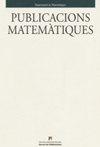加权平方函数不等式
IF 1
3区 数学
Q2 MATHEMATICS
引用次数: 7
摘要
对于可积函数f在[0,1)d上,设S(f)和M f分别表示相应的并进平方函数和f的并进极大函数。本文包含下列陈述的证明。(i)如果w是[0,1)d上的二进A1权值,则||S(f)||L1(w)≤√5[w] 1/2 A1 ||M f||L1(w)。指数1/2是最好的。(ii)对于任何p > 1,不存在仅依赖于p的常数cp, αp,使得对于所有并矢Ap权值w在[0,1)d上,||S(f)| L1(w)≤cp[w] αp Ap |M f| L1(w)。本文章由计算机程序翻译,如有差异,请以英文原文为准。
Weighted square function inequalities
For an integrable function f on [0, 1)d, let S(f) and M f denote the corresponding dyadic square function and the dyadic maximal function of f, respectively. The paper contains the proofs of the following statements. (i) If w is a dyadic A1 weight on [0, 1)d, then ||S(f)||L1(w) ≤√ 5[w] 1/2 A1 ||M f||L1(w). The exponent 1/2 is shown to be the best possible. (ii) For any p > 1, there are no constants cp, αp epending only on p such that for all dyadic Ap weights w on [0, 1)d, ||S(f)||L1(w) ≤ cp[w] αp Ap ||M f||L1(w).
求助全文
通过发布文献求助,成功后即可免费获取论文全文。
去求助
来源期刊
CiteScore
1.60
自引率
0.00%
发文量
29
审稿时长
>12 weeks
期刊介绍:
Publicacions Matemàtiques is a research mathematical journal published by the Department of Mathematics of the Universitat Autònoma de Barcelona since 1976 (before 1988 named Publicacions de la Secció de Matemàtiques, ISSN: 0210-2978 print, 2014-4369 online). Two issues, constituting a single volume, are published each year. The journal has a large circulation being received by more than two hundred libraries all over the world. It is indexed by Mathematical Reviews, Zentralblatt Math., Science Citation Index, SciSearch®, ISI Alerting Services, COMPUMATH Citation Index®, and it participates in the Euclid Project and JSTOR. Free access is provided to all published papers through the web page.
Publicacions Matemàtiques is a non-profit university journal which gives special attention to the authors during the whole editorial process. In 2019, the average time between the reception of a paper and its publication was twenty-two months, and the average time between the acceptance of a paper and its publication was fifteen months. The journal keeps on receiving a large number of submissions, so the authors should be warned that currently only articles with excellent reports can be accepted.

 求助内容:
求助内容: 应助结果提醒方式:
应助结果提醒方式:


